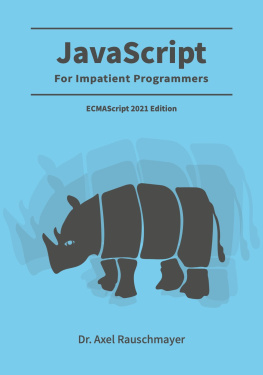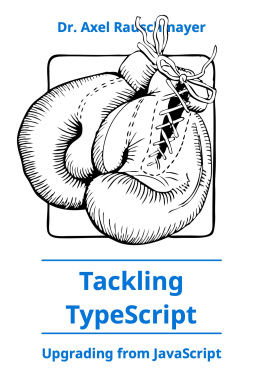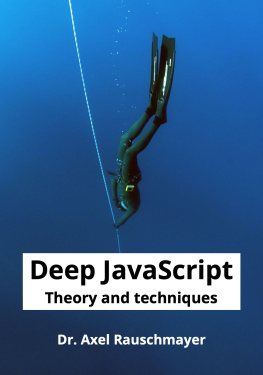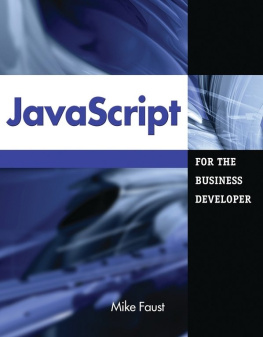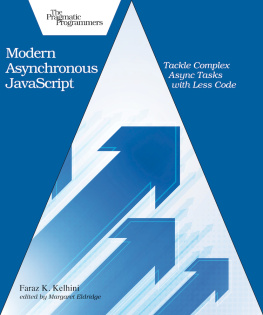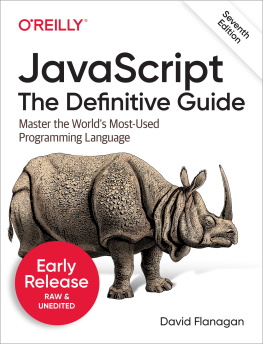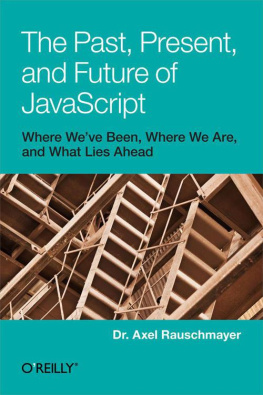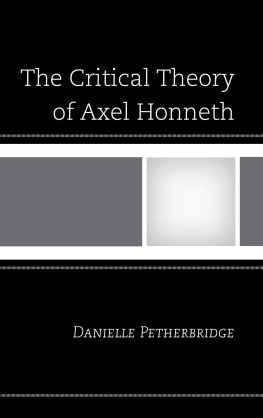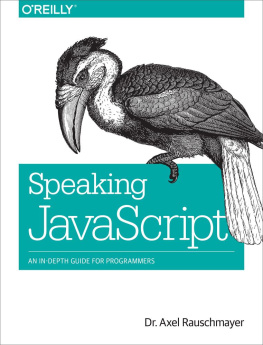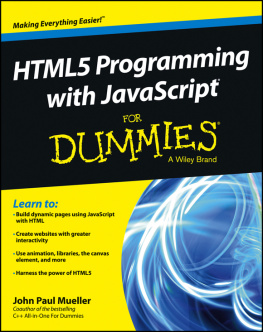JavaScript for impatient programmers (ES2021 edition)
JavaScript for impatient programmers (ES2021 edition)
Dr. Axel Rauschmayer
2021
JavaScript for impatient programmers (ES2021 edition)
1Before you buy the book
1.1About the content
1.1.1Whats in this book?
This book makes JavaScript less challenging to learn for newcomers by offering a modern view that is as consistent as possible.
Highlights:
- Get started quickly by initially focusing on modern features.
- Test-driven exercises and quizzes available for most chapters.
- Covers all essential features of JavaScript, up to and including ES2021.
- Optional advanced sections let you dig deeper.
No prior knowledge of JavaScript is required, but you should know how to program.
1.1.2What is not covered by this book?
- Some advanced language features are not explained, but references to appropriate material are provided for example, to my other JavaScript books at
ExploringJS.com, which are free to read online. - This book deliberately focuses on the language. Browser-only features, etc. are not described.
1.1.3Isnt this book too long for impatient people?
There are several ways in which you can read this book. One of them involves skipping much of the content in order to get started quickly. For details, see .
1.2Previewing and buying this book
1.2.1How can I preview the book, the exercises, and the quizzes?
Go to the homepage of this book:
- All essential chapters of this book are free to read online.
- The first half of the test-driven exercises can be downloaded.
- The first half of the quizzes can be tried online.
1.2.2How can I buy a digital version of this book?
There are two digital versions of JavaScript for impatient programmers:
- Ebooks: PDF, EPUB, MOBI, HTML (all without DRM)
- Ebooks plus exercises and quizzes
The home page of this book describes how you can buy them.
1.2.3How can I buy the print version of this book?
The print version of JavaScript for impatient programmers is available on Amazon.
1.3About the author
Dr. Axel Rauschmayer specializes in JavaScript and web development. He has been developing web applications since 1995. In 1999, he was technical manager at a German internet startup that later expanded internationally. In 2006, he held his first talk on Ajax. In 2010, he received a PhD in Informatics from the University of Munich.
Since 2011, he has been blogging about web development at 2ality.com and has written several books on JavaScript. He has held trainings and talks for companies such as eBay, Bank of America, and OReilly Media.
He lives in Munich, Germany.
1.4Acknowledgements
- Cover by Fran Caye
- Parts of this book were edited by Adaobi Obi Tulton.
- Thanks for answering questions, discussing language topics, etc.:
- Allen Wirfs-Brock (
@awbjs) - Benedikt Meurer (
@bmeurer) - Brian Terlson (
@bterlson) - Daniel Ehrenberg (
@littledan) - Jordan Harband (
@ljharb) - Maggie Johnson-Pint (
@maggiepint) - Mathias Bynens (
@mathias) - Myles Borins (
@MylesBorins) - Rob Palmer (
@robpalmer2) - ime Vidas (
@simevidas) - And many others
- Thanks for reviewing:
[Generated: 2021-02-05 10:31]
2FAQ: book and supplementary material
This chapter answers questions you may have and gives tips for reading this book.
2.1How to read this book
2.1.1In which order should I read the content in this book?
This book is three books in one:
- You can use it to get started with JavaScript as quickly as possible. This mode is for impatient people:
- Start reading with .
- Skip all chapters and sections marked as advanced, and all quick references.
- It gives you a comprehensive look at current JavaScript. In this mode, you read everything and dont skip advanced content and quick references.
- It serves as a reference. If there is a topic that you are interested in, you can find information on it via the table of contents or via the index. Due to basic and advanced content being mixed, everything you need is usually in a single location.
play an important part in helping you practice and retain what you have learned.
2.1.2Why are some chapters and sections marked with (advanced)?
Several chapters and sections are marked with (advanced). The idea is that you can initially skip them. That is, you can get a quick working knowledge of JavaScript by only reading the basic (non-advanced) content.
As your knowledge evolves, you can later come back to some or all of the advanced content.
2.1.3Why are some chapters marked with (bonus)?
The bonus chapters are only available in the paid versions of this book (print and ebook). They are listed in the full table of contents.
2.2I own a digital version
2.2.1How do I submit feedback and corrections?
The HTML version of this book (online, or ad-free archive in the paid version) has a link at the end of each chapter that enables you to give feedback.
2.2.2How do I get updates for the downloads I bought at Payhip?
The receipt email for the purchase includes a link. Youll always be able to download the latest version of the files at that location.
If you opted into emails while buying, youll get an email whenever there is new content. To opt in later, you must contact Payhip (see bottom of payhip.com).
2.2.3Can I upgrade from package Ebooks to package Ebooks + exercises + quizzes?
Yes. The instructions for doing so are on the homepage of this book.
2.3I own the print version
2.3.1Can I get a discount for a digital version?
If you bought the print version, you can get a discount for a digital version. The homepage of the print version explains how.
Alas, the reverse is not possible: you cannot get a discount for the print version if you bought a digital version.
2.3.2Can I submit an error or see submitted errors?
On the homepage of the print version, you can submit errors and see submitted errors.
2.3.3Is there an online list with the URLs in this book?
The homepage of the print version has a list with all the URLs that you see in the footnotes of the print version.
2.4Notations and conventions
2.4.1What is a type signature? Why am I seeing static types in this book?
For example, you may see:

